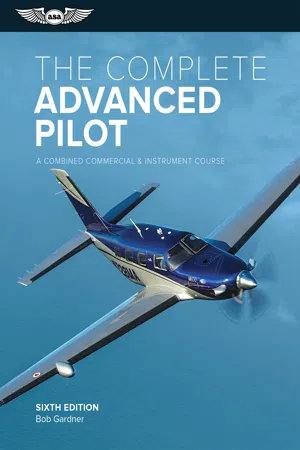![]()
You and Your Flight Instruments
The FAA will test your knowledge of the flight instruments on both the commercial and instrument knowledge examinations. The material in this chapter applies to both.
When you begin training for the instrument rating you must make a mental commitment to believe the indications of the flight instruments and to ignore physical clues to flight attitude. The days of instrument flight by “the seat of your pants” never existed. It takes commitment and concentration to sit in a cockpit with nothing to look at but a collection of gauges and to feel comfortable and confident in your ability to control the airplane, to know its position in space, and to guide it safely to your destination. It’s an ego trip. Pilots are a special group, and instrument pilots are the cream of the crop.
It’s difficult to place your faith in an instrument unless you know how it works, where it gets its information, and how to use its indications to control the airplane. We’ll begin with how the flight instruments work and then examine the systems that allow them to function. In the next chapter, we will discuss how to develop the most efficient method of scanning the instruments.
The six basic flight instruments are divided into two groups by source of power or input: pitot-static and gyroscopic. Your knowledge of how each instrument derives its input will help you troubleshoot any erratic indications and isolate the instrument or system which has failed.
It’s a Whole New World
For the immediate future, FAA Knowledge Exams will assume that your trainer has analog instruments, an arrangement known to pilots as a six-pack, and questions will be based on that assumption. Although there are a lot of whiz-bang new airplanes with digital instrumentation, chances are that you will train in an older plane with a six-pack. Your knowledge test will include questions about satellite navigation regulations and requirements but you will not be asked to interpret a display.
An electronic flight display, when compared to the legacy analog instruments, offers new capabilities and simplifies the flying task. The following sections will discuss where and how those instruments get their inputs. (To learn more, go to www.faa.gov and search for the Advanced Avionics Handbook, FAA-H-8083-6.)
Digital instruments get information from an Attitude and Heading Reference System (AHRS), a collection of solid-state or micro-electromechanical systems (MEMS) providing pitch, heading, and yaw signals to an electronic display. The errors inherent in analog instruments, which I discuss in detail, are vanishingly small in digital displays…until the power fails, in which case you must fall back on the required analog instruments: attitude indicator, airspeed indicator, and altimeter, all of which, hopefully, have power sources independent of ship’s power.
The avionics industry has developed a number of battery-powered digital systems, some handheld, to solve this problem. I recommend that you invest in one.
One step up from the AHRS is the air-data reference system (ADHRS), which incorporates positioning information from a Global Positioning System (GPS) navigator plus airspeed and altitude into the basic AHRS.
Pitot-Static Instruments
The pitot-static system consists of a pitot (pressure-sensing) tube, a static (zero pressure) source, and related plumbing and filters. The pitot-static instruments are the airspeed indicator, the altimeter, and the vertical speed indicator; they measure changes in air pressure caused by the airplane’s vertical and horizontal movements in the atmosphere (see Figure 1-1).
Figure 1-1. Pitot-static system
Table 1-1. Pitot-static system failures
Airplanes equipped for instrument flight have pitot tube heaters, virtually identical to the resistance elements in your kitchen toaster, and they soak up a prodigious amount of electricity. Airplanes approved for instrument flight in commuter or on-demand operations must have pitot tube heaters. The pitot heat should be turned on before you fly into visible moisture, so that ice has no opportunity to form on the pitot tube. If water gets into the pitot plumbing it will cause erratic indications or worse. When the tubing connecting the pitot head to the airspeed indicator is blocked by ice, the air trapped between the point of blockage and the diaphragm in the instrument will expand as the airplane climbs, and the airspeed indicator will react as an altimeter, indicating higher airspeeds as altitude increases. A cross-check of the other instruments (especially the altimeter and VSI) will quickly pinpoint the ASI as having failed.
As a professional pilot or as a private pilot with a professional attitude, you should know what airspeed will result from a given pitch attitude and power setting; that is, you should be able to fly the airplane without an airspeed indicator if that becomes necessary in an emergency.
The static port is located where the airplane’s motion through the air will create no pressure at all: on the side (or both sides) of the fuselage or on the back of the pitot tube. The airspeed indicator is calibrated to read the difference in pressure between impact air and still (static) air—both inputs are required.
If either the pitot tube or the static port is blocked the system will be useless, much like trying to get electricity from only one side of an electrical outlet. Blockage of the static system would disable the airspeed indicator, the altimeter, and the vertical speed indicator because no pressure differential would exist.
Depending on the location of the static source or sources, structural icing might cause such a blockage, and many all-weather airplanes are equipped with electrical static port heaters to eliminate this hazard.
Although an alternate static source is not required by 14 CFR 91.205 for noncommercial instrument flight, most IFR airplanes are equipped with one. (Part 135 requires an alternate static source for passenger-carrying flights operating under instrument flight rules.)
The alternate static source is a small valve or petcock at the pilot station which, when opened, vents the static system to the cockpit. When it is in use, the altimeter and airspeed indicator read slightly high; the vertical speed indicator will indicate correctly after momentarily reading in reverse. Opening the cabin vents will affect the readings of pitot-static instruments by slightly pressurizing the cabin when the alternate static source is being used.
If you are flying in icing conditions and your airplane does not have an alternate static source, water freezing in the static plumbing will put the pitot-static instruments out of commission. Your only option is to open the system to cabin pressure by breaking the glass on the vertical speed indicator. That will render the VSI pretty much useless but save the day for the airspeed indicator and altimeter. The VSI isn’t a required instrument anyway.
The Federal Aviation Regulations require that the altimeter and static system of any airplane used for instrument flight be inspected every 24 months, and that the logbook endorsement indicate the maximum altitude to which the system has been tested. For unpressurized airplanes this altitude will far exceed the service ceiling of the airplane.
Airspeed Indicator
The airspeed indicator requires input from both the pitot (pressure) and static (unchanging) sources. Air from the static port fills the airspeed instrument c...



